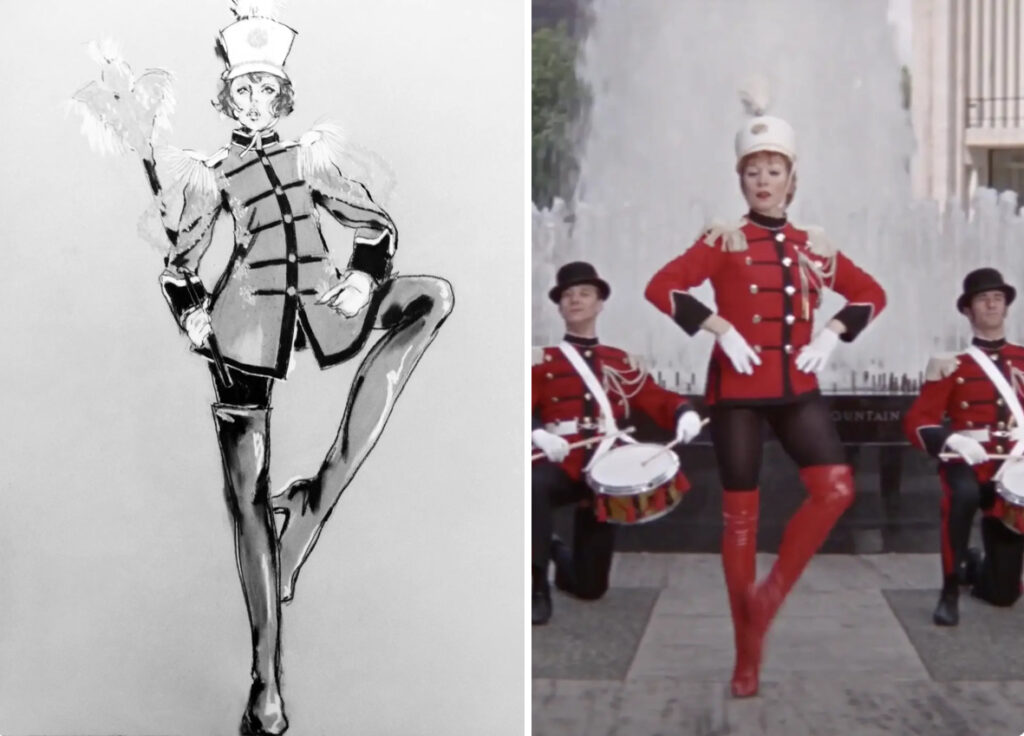Edith Head’s contributions to the world of costume design remain unparalleled, and her work in the 1969 film “Sweet Charity” is no exception. Known for her deep understanding of character, story, and visual aesthetics, Head was able to transform a mere concept into a physical manifestation of personality and emotion through the clothing she designed. One particularly outstanding example of her brilliance can be seen in the design of the costume for Shirley MacLaine’s character, Charity Hope Valentine, during the “I’m a Brass Band” number. This sequence not only highlights the visual exuberance of the film, but also serves as a profound statement about the role of costume design in cinema. In the following review, we will explore the importance of costume design in film, focusing on the side-by-side comparison of Edith Head’s original sketch for Charity’s costume and its actualization in the movie, along with its thematic and narrative significance.
Edith Head’s Costume Design Philosophy
Edith Head was widely celebrated for her philosophy that costume design should not only enhance the actor’s appearance, but also deepen the understanding of the character and the story. For her, the costumes in film were never merely ornamental; they were an integral part of the storytelling process. Her genius lay in her ability to reflect the emotions, motivations, and development of characters through the clothing they wore. This philosophy shines through in “Sweet Charity”, a film directed by Bob Fosse that revolves around the optimistic but troubled Charity Hope Valentine, a dance-hall hostess searching for love and happiness.
The character of Charity is vibrant, quirky, and full of hope despite her personal setbacks, and Edith Head’s costume design for her in the “I’m a Brass Band” scene encapsulates this essence perfectly. The outfit needed to embody both Charity’s lively spirit and her desperate need for recognition and self-assurance. Head achieves this by dressing Charity in a dazzling red and gold band uniform, a bold choice that stands out visually and metaphorically.
The Sketch vs. The On-Screen Costume
When comparing Head’s original sketch for Charity’s “I’m a Brass Band” costume with the final on-screen version, what immediately stands out is how faithful the final costume is to the initial concept. In the sketch, Head meticulously details every aspect of the costume, from the sharp lines of the band jacket to the glittering accents, reflecting Charity’s larger-than-life personality. The uniform is adorned with military-style epaulets and braiding, which not only capture the idea of a brass band leader but also evoke a sense of strength and power. This is a deliberate choice, as Charity, at this point in the film, feels as though she is marching triumphantly through life, ready to conquer the world despite her past disappointments.
On screen, the colors are bolder and more vibrant than in the sketch, with the bright red and gold hues radiating energy and confidence. This is a visual representation of Charity’s emotional state—optimistic and ready to seize her happiness. The costume itself is functional in its tailoring, allowing MacLaine to perform the complex choreography with ease, but it also maintains a sense of theatrical flair with the sharp shoulders, high collar, and sparkling embellishments. The band uniform is a striking contrast to the more demure, everyday outfits Charity wears earlier in the film, signaling a moment of transformation for the character.
Thematic and Narrative Pertinence of the Costume
The costume’s bold design, with its clean lines and strong colors, reflects the exuberance of the “I’m a Brass Band” number and Charity’s emotions. At this moment, she is full of hope, joy, and excitement, believing she has found love and purpose. The uniform she wears is symbolic of her belief that she is marching toward her own personal victory, leading the parade of her own life. The militaristic elements of the costume emphasize the sense of determination and resolve, as though Charity is leading herself into battle—one where she is determined to emerge victorious.
However, as the film progresses, this optimism is shattered, and the uniform becomes a poignant reminder of the fleeting nature of Charity’s dreams. The very same costume that made her feel powerful and invincible during the “I’m a Brass Band” number is later revealed to be a costume in the literal sense—an outer shell that hides her vulnerability. Edith Head understood this duality and designed the uniform to play into this tension between fantasy and reality. Charity’s journey in the film is one of constant struggle between the hope of achieving her dreams and the harsh reality of life’s disappointments, and the costume captures this inner conflict.
Costume as Characterization
The brilliance of Edith Head’s work lies in her ability to use costume as a tool of characterization. In “Sweet Charity”, the wardrobe reflects Charity’s emotional journey, with the “I’m a Brass Band” costume serving as a particularly significant turning point. Before this moment, Charity is often seen in simple, unassuming outfits, reflecting her status as an ordinary woman with extraordinary dreams. The switch to the bold, flashy band uniform signals a change in Charity’s mindset—she is no longer just dreaming of a better life, she believes she is living it. The costume reflects her newfound confidence and serves as a visual representation of her internal transformation.
Moreover, Head’s attention to detail in the costume’s construction is a testament to her understanding of how clothing can inform an actor’s performance. The structure of the band uniform, with its tailored fit and bold design, forces Shirley MacLaine to carry herself in a more confident and authoritative manner. This aligns with Charity’s emotional state in the scene, as she believes she is finally in control of her destiny. By designing a costume that physically alters the way the actor moves and behaves, Head ensures that the clothing becomes an extension of the character, further immersing the audience in Charity’s world.
Influence
Edith Head’s legacy as one of Hollywood’s greatest costume designers is firmly cemented in film history, and her work on “Sweet Charity” is a prime example of why she is so revered. Her ability to blend practicality with visual storytelling, while always keeping the character and narrative at the forefront of her designs, set her apart from her contemporaries. The “I’m a Brass Band” costume is not just a piece of clothing; it is a reflection of Charity’s hopes, dreams, and eventual heartache.
In the broader context of film history, Head’s work helped to elevate the role of the costume designer from merely dressing actors to being an integral part of the storytelling process. Her designs were often so iconic that they became synonymous with the films themselves—think of the little black dress she designed for Audrey Hepburn in “Breakfast at Tiffany’s”. Similarly, the band uniform in “Sweet Charity” is one of the most memorable aspects of the film, a visual representation of the character that is instantly recognizable even to those who may not have seen the movie.
Edith Head’s costume design for Shirley MacLaine’s character in the “I’m a Brass Band” number in “Sweet Charity” is a masterclass in how clothing can be used to enhance character development and support the narrative. The side-by-side comparison of the sketch and the final costume reveals the meticulous attention to detail and the thought process that went into bringing Charity’s character to life. The costume serves not only as a reflection of Charity’s internal state but also as a symbol of her hopes and dreams. Edith Head’s work on “Sweet Charity” is a testament to the power of costume design in film, and her legacy continues to influence designers and filmmakers to this day.
No comments yet.








